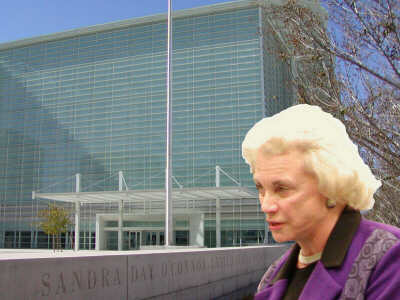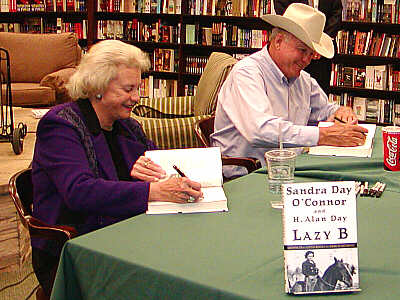|
In 1999 Arizona's U.S. Senators Jon
Kyle and John McCain introduced legislation to name a new federal
courthouse under construction at 401 W. Washington Street after the
state's most distinguished jurist. It is unusual for a federal
building to be named after a public servant who is still serving,
but Sandra Day O'Connor is an unusual woman.
Born in 1930, in El Paso, Texas, and raised on a 160,000 acre
family ranch in southeast Arizona where the nearest neighbor was 25
miles away, Sandra Day learned to drive, ride horses, and shoot
rifles by the time she was eight when her only brother was born.
After graduating from high school at 16, she received a bachelor's
degree magna cum laude at Stanford University majoring in economics
which she believe would be helpful in managing the ranch.
Inspired by a legal dispute over the family ranch, she went on to
study law at Stanford where she received her law degree in two years
instead of the usual three.
While studying law, she met two men with whom she was destined to
have long lasting and rewarding relationships. Graduating
first in the class of 102 law students was William H. Rehnquist.
He would precede Sandra Day to the U.S. Supreme Court with his
appointment in 1971, becoming Chief Justice in 1986, and would be
her conservative mentor on the bench.
She would have closer ties with the other man she met in law
school, John Jay O'Connor. With him, she would share over 50
years of marriage, three sons, and a life in the law.
In the 1950's--the era of Perry Mason--it was not easy for a
woman, even one who had graduated third in her law class, to find
employment as a lawyer. Seeking a position in California, the
best offer she received from any law firm was that of legal
secretary. Years later, a senior partner in the firm making
the offer would assist her nomination to the Supreme Court from his
subsequent position as Attorney General.O1
Upon settling in Arizona with her husband who was to achieve
prominence as a senior partner in major law firm, Sandra Day
O'Connor was again unable to find employment in a private firm, so
she started her own practice. While taking time off to be a
full time mother, she devoted much time to volunteer work and
becoming active in the Republican Party. After returning to
work as an assistant state attorney general, she was appointed to
fill a vacated state senate seat, to which she won election in the
subsequent two terms, eventually becoming the first female majority
leader in any state legislature.
In 1974, before the present system of judicial appointments, she
successfully ran for Maricopa County Superior Court judge. In
1979, she was appointed to the Court of Appeals by the state's
Democrat governor. Within two years, President Ronald Reagan
would nominate her to become, in 1981, the first woman to serve on
the United States Supreme Court.
Known as a conservative on the court, she has not been reluctant
to take moderate positions becoming the swing vote on many issues.
Her independence of judgment led Time magazine to list her as the
fifth most powerful person in Washington in 1993. A panel of
six academic and popular historians assembled by The Arizona
Republic to mark Arizona's 90th year of statehood named Sandra Day
O'Connor as the eighth most important person in Arizona's history.
The New York architects that
designed the courthouse, Richard
Meier & Partners, conceived the six story glass roofed and
walled atrium as a transitional space between the hot, dry desert
outdoors and the air conditioned courtrooms. To cool this
space, they would use what they describe as the "phenomenon of
adiabatic cooling," in which "the increase in the humidity
of a given space generates a substantial drop in air temperature,
without a significant addition of energy."O2
Phoenix residents would describe the concept using the less
eloquent terms "evaporative" or "swamp" cooling.
Had designers asked residents familiar with swamp cooling in the
hot, humid late summer days, they may have also heard the phrase,
"it doesn't work."
In the first summer, visitors who were able to dash across the
atrium to the air conditioned office spaces and courtrooms managed
just fine. The security guards that had to man their stations
hours at a time fared less well. A special authorization from
Washington D.C. allowed them to forgo their traditional coats and
ties in favor of Mexican style guayabera shirts, but still sweat
trickled down their collars.
New lawyers sweating through swearing in ceremonies in May heard
the Chief Justice of the Arizona Supreme Court, Thomas Zlaket, joke
that steamy situation seemed ripe for a lawsuit, while a judicial
assistant quipped that this could be one of the new lawyer's first
case. |
 |
| U. S. Supreme Court Justice
Sandra Day O'Connor superimposed in front of the Federal
Courthouse named in her honor. 2-02 |
 |
| Visitors to the Sandra Day
O'Connor Federal Courthouse pass through a very uncourtlike
glass enclosed atrium which could aptly be described as a
hothouse. The cylindrical glass center point houses a
ceremonial courtroom. 2-02 |
 |
| Justice O'Connor and her brother
put out an extraordinary effort to sign 600 copies of their
book about growing up on an Arizona ranch, much to the
appreciation of admirers packing the Barnes & Noble
bookstore in north Phoenix. 2-02 |
|
Footnotes and Sources for Sandra Day O'Connor and Her
Courthouse:
O1. William
French Smith (1917-1990), U.S. Attorney General, 1981-85.
Lawrence Kestenbaum, Index
to Politicians: Smith, U to Z, The
Political Graveyard, accessed 2-21-02. 
O2. Federal
Building & United States Courthouse Phoenix, Arizona, Richard
Meier & Partners, accessed 2-20-2002. 
________, "KYL, MCCAIN SEEK TO NAME COURTHOUSE
FOR SANDRA DAY O'CONNOR." Capitol Hill Press Releases,
09-16-1999.
________, "THE WEEK: THE 10 MOST POWERFUL PEOPLE
IN WASHINGTON." Time, 05-31-1993, pp 16.
Goldman, Jerry, "Sandra
Day O'Connor Biographical Sketch," The
Oyez Project, Northwestern
University, � 1996-2002.
O'Connor, Sandra Day, and H. Alan Day, Lazy
B--Growing up on a cattle ranch in the American Southwest,
Random House, New York, 2002.
Pitzl, Mary Jo, "Courthouse hothouse," The
Arizona Republic, September 8, 2001, p. B1.
Richard de Uriarte, "THE 10 MOST IMPORTANT PEOPLE
IN ARIZONA HISTORY." The Arizona Republic, 02-10-2002,
pp V1. |


